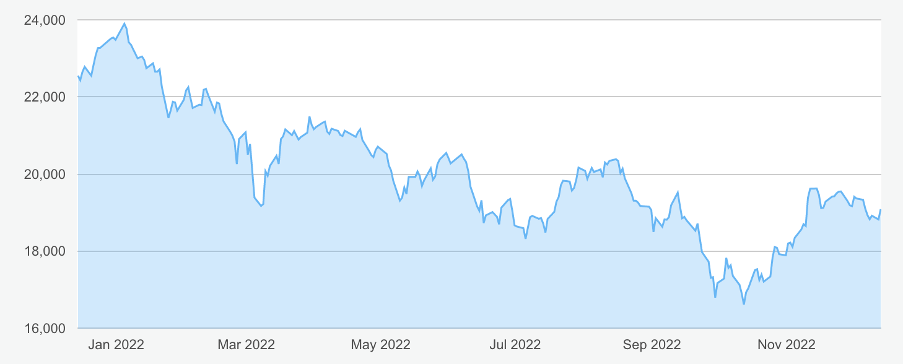10 high-yield mid-cap income shares for dividend investors
14th December 2022 13:58
by Ben Hobson from interactive investor
With inflation set to remain high in 2023, stock screen expert Ben Hobson thinks these ‘unusually cheap’ mid-cap stocks with above-average dividend yields are worth tracking.

Runaway inflation has been one of the big headaches in the stock market this year. Rising input prices and squeezed consumer spending have dented company profits. With fears of a looming recession, it’s no surprise that share prices have been under pressure.
While there are signs that high and rising inflation might ease in 2023, it’s unlikely to drop to previous low levels any time soon. For investors that means one thing: investments are going to have to work much harder in 2023 to deliver inflation-beating returns.
- Read more on: Stocks & Shares ISAs | ISA Investment Ideas | Transferring a Stocks & Shares ISA
As this year draws to a close, one option is to look to UK mid-caps, where a broad sell-off this year has left many on much improved valuations and pushed dividend yields higher. Dividends from this part of the market could prove to be a useful source of returns.
Mixing it up with the mid-caps
To understand mid-cap performance this year it’s worth starting with a look at the top of the market. Britain’s biggest shares have held up reasonably well in 2022. The main FTSE 100 index is currently flat for the year, making it one of the better performing indices anywhere in the world.
In part that performance has been driven by resilience in sectors where the top 100 is strong: energy, utilities and defensive industries have done well. The strength of the US dollar, and to a lesser extent the euro, have also played a part because they account for more than 70% of revenues generated by blue-chips. So there has been a currency tailwind for these stocks, too.
But look further along the market cap spectrum and the performance picture isn’t quite as rosy. Mid-cap shares - in the £500 million to £3 billion range - have had a hard year.
That market cap span captures a large part of the FTSE 250 index, together with slices of the FTSE SmallCap and AIM 50 indices. It’s an area of the market where a large chunk of revenues come from abroad but there’s an undeniable sense of domestic exposure. These shares are more aligned to events and economics in the UK, so they’ve been under greater pressure.
It’s no surprise then that the FTSE 250 is down by 20.5% so far this year.

Source: interactive investor - FTSE 250 1-year performance
One of the most telling measures of this major sell-off is that the overall dividend yield for the index has shifted markedly higher through the year.
As a reminder, the yield on any asset is a measure of the income it pays. With shares, the percentage is calculated by dividing the dividend-per-share by the share price.
The way that yield calculation works means that when a share price falls the yield on the share will rise (all else being equal). That’s what we’ve seen in the market this year.
Research by Link Asset Services shows that in early 2022, the overall expected yield for the FTSE 250 this year was 2.1%. But as prices fell, that expected yield became a distant memory. By the end of September the 12-month forecast yield had jumped to 3.2%.
- Insider: recovery buying at ex-FTSE 250 firm and Naked Wines
- Investor poll: fears, predictions and strategies for 2023
As it stands today, some forecasts put the expected yield for the FTSE 250 at 4.2%. That kind of yield is historically much more in line with what you’d expect in the FTSE 100, where dividends tend to be much higher but company growth tends to be lower.
While it's true that companies still face uncertain economic headwinds, there is an argument here that the market has priced-in a lot of that bad news for mid-caps - and that they look unusually cheap.
When it comes to dividends, of course, the risk is that those companies concerned about the conditions will ratchet down their payouts to protect themselves.
So in the hunt for momentary high yielding mid-caps, it is more important than ever to check that companies have a big buffer of earnings to defend their payouts. Dividend cover of at least 2x, meaning that profits could cover the dividend twice-over, is a starting point here.
This screen focuses on companies with market caps between £500 million and £3 billion. Most (but not all) of them are in the FTSE 250. It looks for above-average dividend yields, strong dividend cover and also shows the number of consecutive years the shares have paid a dividend. The table also shows how the share prices have performed relative to the FTSE All-Share index this year.
Name | Market cap (£m) | Forecast yield (%) | Forecast dividend cover | Consecutive years of dividend payments | Price performance relative to FTSE All-Share in 2022 | Sector |
2,400 | 6.5 | 2.7 | 31 | -40.6 | Home Construction | |
728 | 6.5 | 2.3 | 27 | -37.2 | Construction | |
1,570 | 6.3 | 2.8 | 2 | -32 | Home Construction | |
2,065 | 6.2 | 3.1 | 8 | -10.8 | Finance and Credit | |
1,240 | 5.9 | 2.3 | 28 | -3.4 | Finance and Credit | |
2,604 | 5.8 | 6.5 | 1 | -7.4 | Oil, Gas | |
1,045 | 5.8 | 2.3 | 12 | -12.1 | Industrial Engineering | |
2,756 | 5.6 | 3.1 | 28 | -2.5 | Investment Banking | |
544 | 5.0 | 2.8 | 28 | -21.6 | Construction | |
758 | 4.0 | 3.2 | 12 | -40.4 | Retailers |
This snapshot of the results reveals a couple of themes. One is that home construction, contracting and engineering are very much in the sweet spot for high yields and good dividend cover. Most of the yields here are well in excess of 5%. They include Bellway (LSE:BWY) and Redrow (LSE:RDW), along with the likes of Morgan Sindall (LSE:MGNS), Vesuvius (LSE:VSVS) and Keller Group (LSE:KLR).
Another theme is that banking and finance shares are also regulars. In the top 10 are OSB Group (LSE:OSB), Paragon Banking Group (LSE:PAG) and Man Group (LSE:EMG).
What this kind of screening approach shows is that the market certainly seems to be anticipating difficult conditions for companies in 2023 - particularly in sectors like construction and finance. Earnings are likely to come under pressure, and there are suggestions that earnings forecasts are still too optimistic.
As a result, many mid-caps have been sharply marked down in price to the point where you could make a case for them being cheap. That appears to be showing up in eye-catching yields.
For investors prepared to brave the conditions, mid-caps may offer an unusually high yielding option. It’s important to remember that dividends are at risk of being cut in tough economic times, so detailed research is essential. But in the search for inflation-beating returns, it could be an area of the market worth watching.
Ben Hobson is a freelance contributor and not a direct employee of interactive investor.
These articles are provided for information purposes only. Occasionally, an opinion about whether to buy or sell a specific investment may be provided by third parties. The content is not intended to be a personal recommendation to buy or sell any financial instrument or product, or to adopt any investment strategy as it is not provided based on an assessment of your investing knowledge and experience, your financial situation or your investment objectives. The value of your investments, and the income derived from them, may go down as well as up. You may not get back all the money that you invest. The investments referred to in this article may not be suitable for all investors, and if in doubt, an investor should seek advice from a qualified investment adviser.
Full performance can be found on the company or index summary page on the interactive investor website. Simply click on the company's or index name highlighted in the article.
Disclosure
We use a combination of fundamental and technical analysis in forming our view as to the valuation and prospects of an investment. Where relevant we have set out those particular matters we think are important in the above article, but further detail can be found here.
Please note that our article on this investment should not be considered to be a regular publication.
Details of all recommendations issued by ii during the previous 12-month period can be found here.
ii adheres to a strict code of conduct. Contributors may hold shares or have other interests in companies included in these portfolios, which could create a conflict of interests. Contributors intending to write about any financial instruments in which they have an interest are required to disclose such interest to ii and in the article itself. ii will at all times consider whether such interest impairs the objectivity of the recommendation.
In addition, individuals involved in the production of investment articles are subject to a personal account dealing restriction, which prevents them from placing a transaction in the specified instrument(s) for a period before and for five working days after such publication. This is to avoid personal interests conflicting with the interests of the recipients of those investment articles.